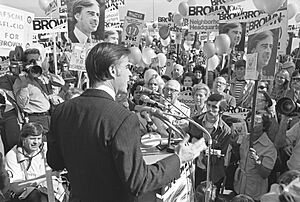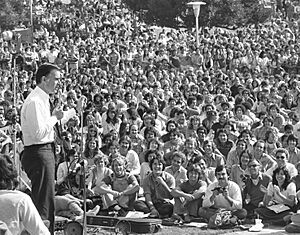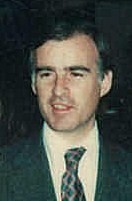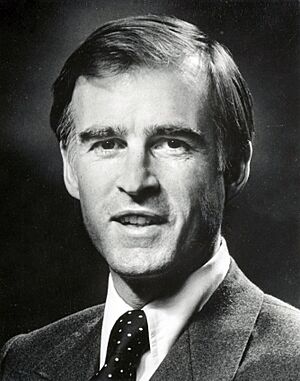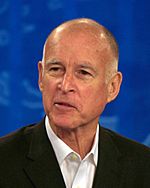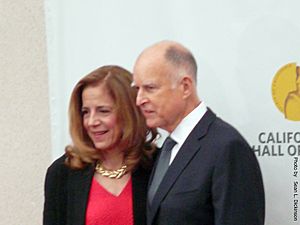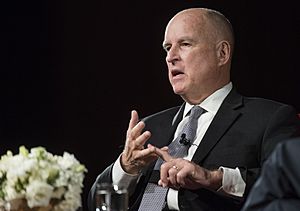Jerry Brown facts for kids
Quick facts for kids
Jerry Brown
|
|
|---|---|
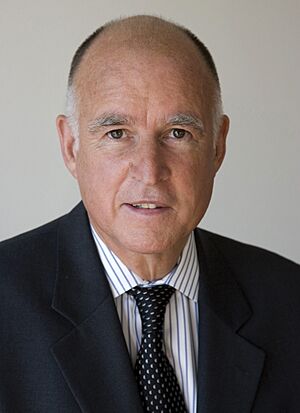
Official portrait, 2006
|
|
| 34th & 39th Governor of California | |
| In office January 3, 2011 – January 7, 2019 |
|
| Lieutenant | Gavin Newsom |
| Preceded by | Arnold Schwarzenegger |
| Succeeded by | Gavin Newsom |
| In office January 6, 1975 – January 3, 1983 |
|
| Lieutenant |
|
| Preceded by | Ronald Reagan |
| Succeeded by | George Deukmejian |
| 31st Attorney General of California | |
| In office January 8, 2007 – January 3, 2011 |
|
| Governor | Arnold Schwarzenegger |
| Preceded by | Bill Lockyer |
| Succeeded by | Kamala Harris |
| 47th Mayor of Oakland | |
| In office January 4, 1999 – January 8, 2007 |
|
| Preceded by | Elihu Harris |
| Succeeded by | Ron Dellums |
| 23rd Secretary of State of California | |
| In office January 4, 1971 – January 6, 1975 |
|
| Governor | Ronald Reagan |
| Preceded by | Frank M. Jordan |
| Succeeded by | March Fong Eu |
| Chairman of the California Democratic Party | |
| In office February 11, 1989 – March 3, 1991 |
|
| Preceded by | Peter D. Kelly III |
| Succeeded by | Phil Angelides |
| Personal details | |
| Born |
Edmund Gerald Brown Jr.
April 7, 1938 San Francisco, California, U.S. |
| Political party | Democratic |
| Spouse |
Anne Gust
(m. 2005) |
| Parents | Pat Brown Bernice Layne Brown |
| Relatives | Kathleen Brown (sister) |
| Residences | Colusa County, California, U.S. |
| Education | Santa Clara University University of California, Berkeley (BA) Yale University (LLB) |
| Signature |  |
Edmund Gerald Brown Jr. (born April 7, 1938), often called Jerry Brown, is an American lawyer and politician. He served as the 34th and 39th governor of California. His terms were from 1975 to 1983 and again from 2011 to 2019.
Brown is a member of the Democratic Party. He was also secretary of state of California (1971–1975). Later, he became mayor of Oakland (1999–2007). He also served as attorney general of California (2007–2011). He holds a unique record as both the oldest and sixth-youngest governor of California. This is because of the 28-year gap between his second and third terms. When he finished his fourth term, Brown became the fourth-longest-serving governor in U.S. history. He served a total of 16 years and 5 days.
Born in San Francisco, California, Jerry Brown is the son of Pat Brown. His father was the 32nd governor of California (1959–1967). After studying at the University of California, Berkeley and Yale Law School, he started his political career. He was elected to the Los Angeles Community College District Board of Trustees. At 36, Brown became the youngest California governor in 111 years. This was after winning his first term in 1974. He won his second term in 1978.
After his first two terms as governor, Brown traveled and then returned to California. He served as the Chairman of the California Democratic Party. He later became mayor of Oakland and then attorney general of California. He was elected for his third and fourth terms as governor in 2010 and 2014. On October 7, 2013, he became the longest-serving governor in the history of California. He surpassed Earl Warren's record.
Contents
Early Life and Education
Jerry Brown was born in San Francisco, California. He was the only son of four children. His father, Pat Brown, was a district attorney and later governor. His mother was Bernice Layne Brown.
Brown attended St. Ignatius High School and graduated in 1955. He then went to Santa Clara University for a year. For a time, he considered becoming a Catholic priest. He studied at a Jesuit novice house from 1956 to 1960.
After that, he enrolled at the University of California, Berkeley. He earned a Bachelor of Arts degree in classics in 1961. He then attended Yale Law School and graduated with a law degree in 1964. After law school, Brown worked for a California Supreme Court justice.
Brown passed the state bar exam on his second try. He then moved to Los Angeles and joined a law firm. In 1969, he ran for the Los Angeles Community College Board of Trustees. This board managed community colleges in the city. He won and served until 1971.
California Secretary of State (1971–1975)
In 1970, Brown was elected California secretary of state. In this role, he fought against large companies. He won cases against them for breaking election laws. He also made sure lawmakers followed rules about sharing campaign information.
Brown helped create and pass the California Political Reform Act of 1974. This law was approved by 70% of California voters. It created the California Fair Political Practices Commission. This commission helps ensure fair political practices.
Governor of California (1975–1983)
First Term as Governor
In 1974, Brown ran for Governor of California. He won the Democratic primary election. Many people knew his father, Pat Brown, which helped him. In the main election, Brown was elected governor. He won against Houston I. Flournoy. He took over from Republican governor Ronald Reagan.
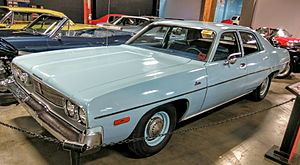
When he became governor, Brown was known for being careful with money. He saved a lot of state funds, leading to a large budget surplus. Brown also avoided many of the special benefits that came with being governor. He chose to rent a simple apartment instead of living in the new governor's mansion. He often walked to work or drove a Plymouth Satellite sedan.
Brown cared a lot about environmental issues. He supported new technologies and reorganized the California Arts Council. He also appointed more women and minorities to government positions than previous governors. In 1977, he supported the first tax break for rooftop solar panels. He also removed a tax break for the state's oil industry.
Brown was against the death penalty. He vetoed it as governor, but the legislature overturned his veto in 1977. He also appointed judges who shared his views on this issue.
In 1978, California voters passed Proposition 13. This law cut property taxes. Brown had initially opposed it. After it passed, he changed his approach and cut state spending. He used the state's budget surplus to help cities and schools deal with less tax money. His actions earned him praise from the author of Proposition 13.
During his first term, Brown also signed laws to improve workers' rights. These included better rights for farmworkers.
1976 Presidential Campaign
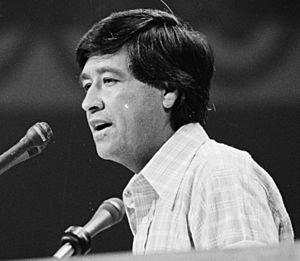
Brown started his first campaign for president in March 1976. He joined the race late. He said, "The country is rich, but not so rich as we have been led to believe. ... In short, we are entering an era of limits."
Brown won primary elections in Maryland, Nevada, and California. He also gained support in other states. However, he could not stop Jimmy Carter from winning the Democratic nomination. Brown finished third in the delegate count.
Second Term as Governor
Brown won re-election in 1978. He defeated Republican state attorney general Evelle J. Younger. During this term, he appointed the first openly gay judge in the United States. This was Stephen Lachs in 1979. He also appointed the first openly lesbian judge, Mary C. Morgan, in 1981.
Brown supported the Peripheral Canal project. This project aimed to move water from the Sacramento River to southern California. Voters rejected the project in 1982.
In 1981, Brown faced a serious problem with medfly insects in the San Francisco Bay Area. These flies were destroying crops. Initially, he allowed only ground-level spraying to protect the environment. But the infestation grew quickly. After a month, he approved a large response. Helicopters sprayed malathion at night. The California National Guard also helped. The infestation was eventually stopped.
Brown suggested creating a state space academy. He also proposed buying a satellite for emergency communications. This idea was similar to one later adopted. A columnist once called him "Moonbeam," a nickname that stuck for a while. However, the columnist later said he regretted publicizing it.
Brown decided not to run for a third term as governor in 1982. Instead, he ran for the United States Senate. He lost to San Diego mayor Pete Wilson. George Deukmejian became the next governor.
1980 Presidential Campaign
In 1980, Brown challenged President Carter for the Democratic nomination again. His platform was much bigger than in 1976. He promised to "Protect the Earth, serve the people, and explore the universe."
His main ideas included a call for a constitutional convention for a Balanced Budget Amendment. He also wanted to increase funding for the space program. He was against nuclear power after the 1979 Three Mile Island accident. Brown also suggested more federal funding for solar power.
Brown's campaign struggled to gain support. He received only 10 percent of the vote in the New Hampshire primary. He eventually had to end his campaign.
After Governorship and Return to Politics
After losing the Senate race in 1982, many thought Brown's political career was over. He traveled to Japan to study Buddhism. He also visited Mother Teresa in Calcutta, India, and helped care for the sick.
In 1988, Brown returned to California. He became the chairman of the California Democratic Party. He worked to expand the party's supporters. In 1991, he resigned to run for president again.
1992 Presidential Campaign
Brown announced his third run for president in 1992. Many in the media did not think he had a chance. He ran a grassroots campaign. He said he would only accept small donations from individuals (no more than $100). He criticized the political system in Washington. He called for term limits for members of Congress.
Brown's platform included supporting living wage laws. He also opposed free trade agreements like NAFTA. He focused on his tax plan, which included a flat tax and a value added tax. This plan was popular with voters. He won surprising victories in Connecticut and Colorado.
Because he had a limited budget, Brown used cable television and talk radio to share his message. He also used a toll-free phone number for fundraising. He won primary elections in Maine, Colorado, Nevada, and Vermont. He became a major challenger to Bill Clinton.
Brown continued to campaign but did not win any more primaries. Despite spending much less money, he won upset victories in seven states. He received a large number of delegates at the 1992 Democratic National Convention. He spoke at the convention but did not endorse Clinton.
Mayor of Oakland (1999–2007)
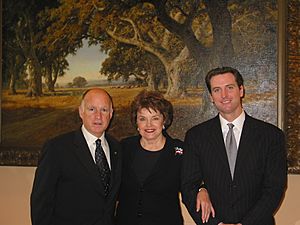
After his 1992 presidential campaign, Brown moved to Oakland, California. He started a national talk radio show from his home. In 1998, Brown ran for mayor of Oakland as an independent. He won with 59% of the vote.
Before taking office, Brown worked to change Oakland's government. He wanted the mayor to have more power. Voters approved this change in 1998. As mayor, Brown focused on improving the city's economy. He helped attract a lot of investment to Oakland. He is credited with starting the revitalization of the city. This included fixing up the Fox Theatre and Jack London Square.
Brown aimed to bring 10,000 new residents to Downtown Oakland. This plan was called the "10k Plan". It led to new housing projects in different parts of the city. He built more affordable housing than previous mayors.
Brown also tried to fix Oakland's schools. He created two charter schools: the Oakland School for the Arts and the Oakland Military Institute. He also worked on reducing crime. Crime decreased by 13 percent overall during his time as mayor. Brown was reelected as mayor in 2002.
Attorney General of California (2007–2011)
In 2004, Brown decided to run for Attorney General of California. He won the Democratic primary and then the general election in 2006. He defeated Republican state senator Charles Poochigian. Brown's eligibility to run was challenged, but the case was dismissed.
Mortgage Fraud Lawsuit
In June 2008, Brown filed a lawsuit against mortgage lender Countrywide Financial. He claimed the company used unfair practices to sell risky mortgages. The lawsuit said the company misled people about loans. The suit was settled in October 2008. The settlement helped modify troubled loans worth billions of dollars.
Governor of California (2011–2019)
Third Term as Governor
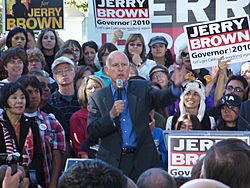
Brown announced his candidacy for governor on March 2, 2010. He ran for a third term. His Republican opponent was former eBay president Meg Whitman. Brown was supported by major newspapers and unions.
Both candidates were criticized for negative campaigning. Brown won the election with 53.8% of the vote. He was sworn in for his third term on January 3, 2011. He worked on a budget that would move many government programs to local control.
In September 2012, Brown signed a law that limited protests at funerals. This was in response to protests by the Westboro Baptist Church.
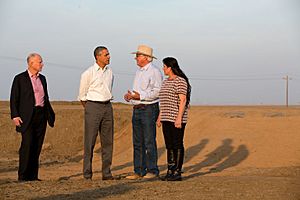
In November 2012, voters approved Brown's tax increases. This was called Proposition 30. It raised income taxes for high earners and increased sales tax. This helped the state avoid cuts to public education.
In 2013, Brown proposed a large water project. It involved building two long tunnels to carry fresh water. This project was planned to be funded by the agencies and users who would benefit from it.
In July 2014, Brown traveled to Mexico. He met with leaders about the children's immigration crisis. In September 2014, he signed a historic law to manage groundwater. This plan aims for water sustainability within 20 years.
Fourth Term as Governor
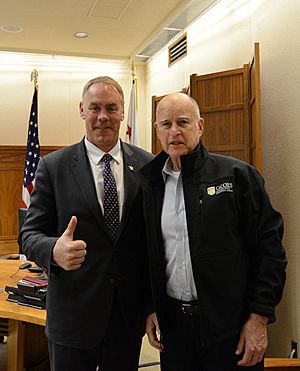
Brown announced his bid for a fourth term on February 27, 2014. He won the primary election. He then advanced to the general election with Republican Neel Kashkari.
There was only one debate between Brown and Kashkari. Kashkari criticized Brown for not improving California's business environment. Brown responded that some proposals, like a large payment for a factory, would be unfair to taxpayers.
Brown said that if he won, he would continue to give more power to local authorities. This included power over education and criminal justice. He also said he would resist new spending proposals from other Democrats.
Brown was re-elected in the general election with 60.0% of the vote. He was sworn in for his final term on January 5, 2015. His goals included building the California High-Speed Rail and improving the state's water system. He also aimed to reduce carbon dioxide emissions.
In October 2015, Brown signed the California End of Life Option Act. This law allows some California residents to choose medical aid in dying. He added a personal message about his thoughts on the ethical issues.
In 2016, Brown vetoed a bill to remove sales taxes on feminine hygiene products and diapers. He said these tax breaks would cost the state too much money.
In 2018, Brown proposed spending $120 million to create California's first online community college. This college was planned to open by fall 2019.
Important laws passed during his final term include California Sanctuary Law SB 54. This law limits cooperation between police and federal immigration agents. He also signed California Senate Bill 32, which sets goals for reducing greenhouse gas emissions. He also passed the Road Repair and Accountability Act.
Brown granted over 1,100 pardons since 2011. This is more than any California governor in recent history. He also commuted more than 82 sentences.
Post-Public Office
After leaving public office, Brown has focused on climate cooperation. He works with groups in the United States and China. He also helped create a new center for California-China climate cooperation at University of California, Berkeley.
Brown lives on a ranch in California. He allows researchers to use it for meetings. In 2023, a new type of beetle was named B. brownorum after Brown and his wife. It was found on their ranch.
Personal Life
During his first terms as governor and mayor, Brown was single. He was known for dating famous women, including singer Linda Ronstadt. In March 2005, Brown announced his engagement to Anne Gust. They had been together since 1990. They married on June 18, 2005, in Oakland. They also had a religious ceremony in San Francisco.
From 1995, Brown hosted a daily call-in talk show on Pacifica Radio. The show and his political group were called We the People. His programs often featured guests and explored different views on social and political topics.
The official portrait of Jerry Brown from his first time as governor was painted by Don Bachardy. It was shown in 1984. The painting has been discussed a lot because it is different from traditional portraits.
In April 2011, Brown had surgery to remove a skin cancer from his nose. In December 2012, he was treated for early stage prostate cancer.
In 2011, Jerry and Anne Gust Brown got a Pembroke Welsh corgi named Sutter Brown. Sutter was called the "first dog" of California. He often appeared with the governor. In 2015, they got a second dog, Colusa "Lucy" Brown. Sutter passed away in December 2016 from cancer.
In 2019, Brown became a visiting professor at Berkeley.
See also
 In Spanish: Jerry Brown para niños
In Spanish: Jerry Brown para niños


